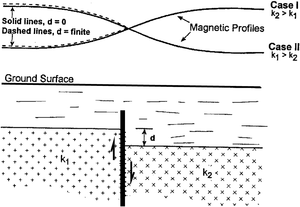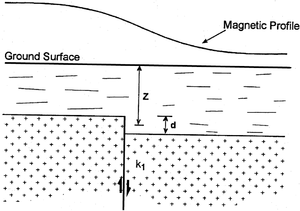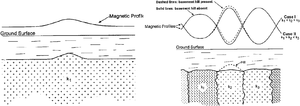Magnetic field: local variations
| Exploring for Oil and Gas Traps | |

| |
| Series | Treatise in Petroleum Geology |
|---|---|
| Part | Predicting the occurrence of oil and gas traps |
| Chapter | Using magnetics in petroleum exploration |
| Author | Edward A. Beaumont, S. Parker Gay |
| Link | Web page |
| Store | AAPG Store |
Variations in the local magnetic field are due mainly to the following:
- Lithologic changes of basement rocks with corresponding differences in magnetite content
- Elevation changes on the top of basement where basement is of uniform magnetic susceptibility (k)
However, lithologic changes tend to overwhelm the magnetic response of elevation changes in basement caused by fault throws or basement highs unless basement is deep (> length::5 km, approximately). In this case the slightly magnetic sedimentary rocks begin to show in the magnetic pattern. Most of this is due to detrital magnetite in sandstones.
Elevation change due to a fault
The presence of a fault is a common interpretation of a magnetic increase or decrease. This interpretation assumes the fault throw, which changes the elevation to the top of basement, is the cause of the anomaly. It also assumes uniform lithology and uniform magnetic susceptibility of basement across a fault. Given this (usually incorrect) assumption, we can calculate the depth of the fault and its throw from the shape and amplitude of an observed magnetic curve. If we do not know the exact susceptibility, we can calculate a series of curves to establish a range of probable values of the throw. In all cases, the magnetic high necessarily appears on the upthrown side of the fault.
In the hypothetical cross section in Figure 1, basement rock has the same susceptibility across the fault.
Lithologic changes due to a fault

Figure 2 shows a fault separating basement blocks of different lithologies and magnetic susceptibilities. If the average magnetic susceptibilities (k1 and k2) of the basement blocks are unknown, then we cannot determine the amount of throw of the fault—we cannot even determine the direction of throw if the signal resulting from susceptibility overrides that due to throw. Since susceptibilities of basement rocks commonly vary by hundreds, even thousands, of percent[2][3][4] and the ratio of throw to depth of a fault can be, at most, 100%, then it follows that in most cases the magnetic response due to susceptibility overrides that due to throw. The result is that many faults (perhaps as high as 40–50%) show a magnetic low on the upthrown side.
The hypothetical cross section shows a fault juxtaposing basement blocks of different lithologies and susceptibilities. The curves above the cross section are the magnetic profiles where the magnetic field is vertical for k1 > k2 and k1 < k2. It assumes no throw on the fault (d = 0). The dashed curves show the magnetic response if the fault has a finite throw (d). Note how little impact the fault throw has on either profile.
Detecting basement hills
The basement hill and obvious magnetic anomaly shown on the left side of Figure 3 assumes a uniform magnetic susceptibility for basement. However, given that basement is usually block faulted, is this type of feature detectable? If we are looking at a topographic prominence centered on a basement block, the detection problem becomes that shown on the right side of the figure. A series of adjacent basement blocks having different magnetic susceptibilities results in a residual magnetic pattern of alternating highs and lows (solid lines).
When the basement block on which the hill is carved is more magnetic than surrounding blocks, the hill contributes slightly to the magnetic high over the block as shown. The slight increase in anomaly amplitude due to the hill (top dashed line) generally is not distinguishable from a similar increase due to a slightly higher magnetic susceptibility for the whole block; hence, the hill is not generally detectable. If the block on which the hill is carved is less magnetic than the adjacent blocks, then the hill results in a lesser amplitude of the magnetic low over that block, but the low is still present (bottom dashed line). The hill generally is not detected.
See also
- Interpreting magnetic data
- Basement fault blocks and fault block patterns
- Magnetics: interpreting residual maps
- Magnetics: petroleum exploration applications
References
- ↑ Gay, S. P., Jr., 1995, The basement fault block pattern: its importance in petroleum explo- ration, and its delineation with residual aeromagnetic techniques, in R. W. Ojakangas, ed., Proceedings of the 10th International Basement Tectonics Conference, p. 159–207.
- ↑ Heiland, C. A., 1946, Geophysical Exploration: Englewood Cliffs, New Jersey, Prentice-Hall, 1013 p.
- ↑ Jakosky, J. J., 1950, Exploration Geophysics: Los Angeles, Trija Publishing Co., 1195 p.
- ↑ Dobrin, M. B., 1960, Introduction to Geophysical Prospecting, 2nd ed.: New York, McGraw-Hill, 446 p.

